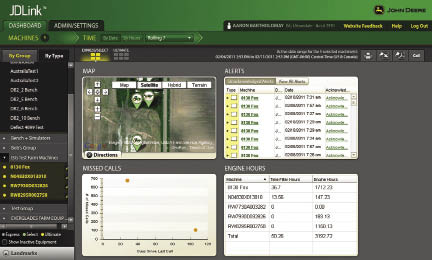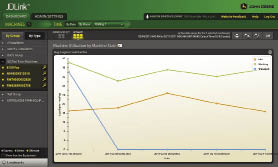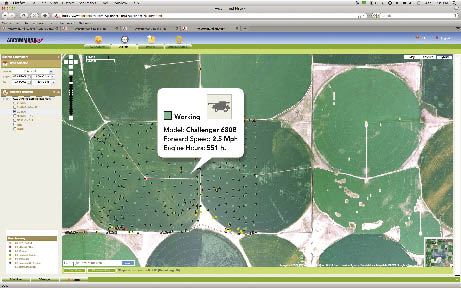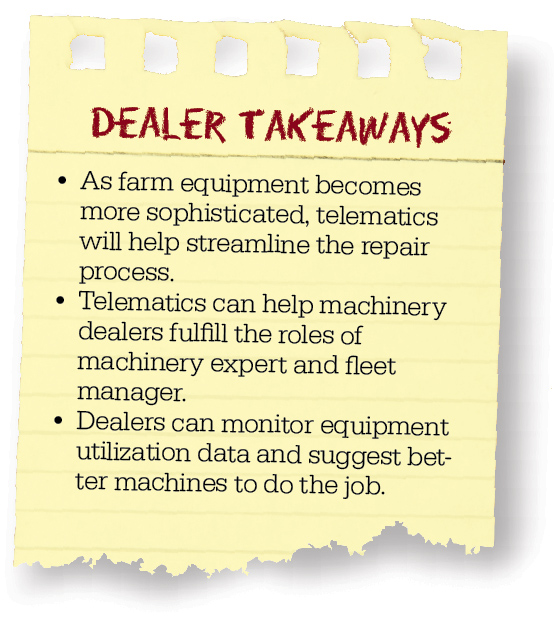Maintaining regular communication with customers is crucial to a farm equipment dealer’s success.
Today, thanks to telematics systems, it’s possible for the tractor itself to be part of that dialogue.
Although this technology is only now beginning to emerge in farm operations, it holds great promise for deepening the relationships dealers have with their farm customers, and has potential for increasing dealer income. In the same way auto-guidance technology makes farmers more productive, telematics systems are tools dealers can use to make their operations more efficient.
Telematics systems use the electronic communication networks embedded in modern farm machinery as well as GPS to monitor and report on information including machine location, hours, trouble codes and precision farming information. Data is transferred via cellular or satellite systems to the Internet or a mobile phone.
"I can see telematics playing a big role for the dealership,” says Derek Strunk, technology manager for Altorfer Ag Products in Clinton, Ill. “But I think the connectivity to a dealership will be more impressive to farmers than machine management.”
For many years, telematics systems have been used by over-the-road truck fleet owners to keep an eye on drivers or by construction contractors to allow them to monitor data such as engine hours without having to travel to the machine.
Until recently, the family farm wasn’t regarded as an area where this technology would find a strong market. That’s changing as equipment becomes more sophisticated.
“The farmer with two tractors and a combine probably doesn’t need help knowing how many hours are on his equipment,” says Terry Burchill, product market analyst for Phoenix Intl. “He’s out in the field operating the equipment and very likely already has tight control of the maintenance schedule. But that changes if he has an issue in the field such as the tractor showing an error code. He may not have the ability to identify the problem at hand. With a telematics system installed, the farmer could get a call from the dealer even before he knows there is a problem with his tractor. The dealer can explain the situation and provide a solution immediately.”
Phoenix Intl. is a John Deere-owned company that provides electronic components, including hardware for telematic systems, to a wide range of OEMs in the off-road and heavy-duty on-road equipment markets. Its staff worked on the development of the Deere-developed JDLink telematics system. JDLink allows the tractor to send location and performance data via the web and cell phone.
The latest telematics systems combine GPS technology with electronic communication systems embedded in modern machines to transmit data. Information such as engine hours and filter life can be reviewed on a website.

Evolving Family Farms
The typical family farm is no longer a few hundred acres and a couple of tractors. Farm operations are expanding in size. “More farmers are running multiple machines in different areas, and they need to know what’s going on with each piece of equipment,” says David Swain, technology marketing specialist for AGCO. “Telematics will play a big role in agriculture. There’s a lot of data being generated by machines that can be used by the farm operator to make decisions ranging from equipment utilization to maintenance.”
AGCO’s AgCommand telematics service monitors machine location, engine and transmission status, hydraulic operations, combine operation information and other data. The user can view the information on a computer connected to the Internet or on a cell phone.
Burchill believes telematics systems are gaining a stronger foothold in the off-highway equipment industry, and soon most machines will have some level of telematics content installed. The commitment by equipment manufacturers to offer it as a factory-installed feature on their machinery will likely prove to be the turning point for the technology’s adoption.
With access to a farmer’s machine-specific data, the dealer will be better equipped to make equipment utilization suggestions. For example, if a “working” tractor is using half of its horsepower, it may be time for a larger implement.

“It’s a big step for the farm side of the off-highway industry to introduce telematics as standard equipment,” says Burchill. “As farmers and dealers adopt the technology, it opens up more possibilities for what we can do with that technology going forward.”
Precision farming specialists Trimble and Raven have also introduced telematics systems for use on the farm. Trimble’s Connected Farm uses Farm Works software to manage data transferred to and from the farm equipment. Raven Industries has introduced a similar service called Slingshot.
Slingshot works with cell phone networks and delivers real-time kinematic (RTK) global positioning system correction signals, data transfer, Internet connection and real-time technical support in the field.
As one of Raven Industries’ largest resellers of precision-ag equipment, self-propelled sprayer manufacturer Equipment Technologies has adopted Slingshot RTK, setting up base stations that cover Indiana and Ohio.
Dealer Advantage
Over-the-road truck fleets have long used telematics systems for asset management, allowing supervisors to monitor what drivers were doing on routes. That technology can now help farmers improve efficiencies in the field. Dealers can use it, too, to help customers get the most out of their machinery investment.
Telematics devices and services have evolved beyond reporting hour and location information to being able to provide machine diagnostic and repair assistance. The dealer’s technician no longer has to drive to the machine to determine the problem.
“If a vehicle has a failure, it can alert the dealer in real-time. Working from an office computer, the technician can connect with the machine as it works in the field and watch what is happening,” says Burchill. “It saves them and their customer time and money. They may know what parts or tools they’ll need to fix the problem before they leave the shop.”
For dealers and farmers, there’s a security measure, as well. Strunk is considering adding telematics systems to Altorfer’s demonstration and lease machines to ensure the equipment is where it’s supposed to be and is not being abused.
Depending on the farm’s level of sophistication, data from the machine can be uploaded automatically into their business system, and can alert the farmer as well as the dealer that it’s time to change an air filter, for example. It also provides the opportunity to send data wirelessly for agronomic purposes, including mapping, fertilizing, seeding and more.
The OEM can use this information, too. “Information provided by telematics systems can strengthen the dealer and OEM relationship, including areas such as warranty management,” says Burchill. “The OEM’s engineering department can use the data to monitor how machines are performing in real-world-conditions to help improve machine design.”
Telematics systems can give dealers an edge when it comes to providing better solutions for their customers.
“In the ag equipment industry, the dealer is often the machine expert,” says Aaron Bartholomay, senior marketing representative, product development for John Deere’s JDLink system. “More than ever, by utilizing telematics data the customer can work with that dealer as a knowledgeable machinery source, with the dealer making recommendations based on the farmer’s specific requirements.”
“Telematics helps open the door for dealers to better understand a customer’s machines and then sell a solution that is tailor fit for their farm,” says Bartholomay.
A dealer could monitor how the farmer is using the tractor and recommend equipment that better fits the application. For example, data being sent to a dealer’s computer could show that a particular farmer is using only 50% of the tractor’s horsepower. That might suggest a larger implement that would make the farmer more productive. If he was using a 12-row planter on large fields, a move to a 24-row unit would allow the farmer to improve his efficiency.
Information provided by the machine can help with trade-ins, too. “The dealer needs to turn trade-in equipment as fast as possible,” says Burchill, “and reviewing usage reports could help the dealer work a deal in reverse.”
If a customer wants to buy a used machine with “X” hours, the dealer can review the data to see what’s out there. They now have a pool of vehicles to review, and can approach the equipment owners to see if they have been thinking of trading up.
Ultimately, it’s up to the farmer how the data produced by the tractors is distributed and used. “Farmers can set it up however they want with the dealer,” says Swain. “For large farms, the dealer can be set up as a fleet manager, monitoring machine functions on a regular basis.”
Or, a notification could be sent only to the farmer when it’s time to change the oil. At the next level of severity, the dealer could get the notification as well, and call to see how the farmer wants it handled. More severe maintenance issues could be programmed to have the system automatically call a technician.
“If a dealer properly articulates the benefits and sets the service program up right,” says Swain, “every tractor he sells means more recurring revenue. There are business opportunities through this tool.”
Before joining Phoenix in 2009, Burchill worked in the field for a dealership. “We installed telematics equipment as part of a dealership promise,” he says. “We worked the cost of the system into the margins of the purchase price, and with it provided a host of other benefits such an extended warranty and service specials.”
The dealer used a service application where hours were recorded and fed into a maintenance scheduler. Service department personnel could be alerted when a particular machine was due for maintenance, and they would follow up with the farmer.
Typical farms are no longer a few hundred acres and a couple of tractors. As farmers expand their operations and add farm equipment to their fleets, telematics systems can help them, as well as their dealers, better manage the equipment.

Farmers as Fleet Managers
One of Altorfer’s customers is already using AGCO’s AgCommand system. “That farmer is seeing a lot of value in it already,” says Strunk. “The operator is using the system’s geo-fence feature to alert the fertilizer plant that a tender truck driver is on his way, and to get the load ready.”
Northeast Iowa farmer Chris Barron recently ordered two John Deere 8R tractors with JDLink, and is looking forward to using the communication systems on the tractors to make running both units in the same field easier to manage while planting.
“That is our main application,” says Barron, director of operations and vice president of Carson and Barron Farms. He also sees the ability to send data back to his main office becoming increasingly valuable as his farm operation grows.
On his farm, Barron collaborates with several other farmers to maintain a shared equipment pool. “As that system grows over time, I see the need for telematics applications because of the way we will be structured.
“The continued consolidation of growers will require the use of telematics systems, too,” he says. “We’ve seen the consolidation of every other sector of the ag industry. I think the last area will be in crops, and as that happens, this technology will become more applicable every year.”
Barron’s dealer will have access to the data streaming from the tractors, while it’s also channeled to his farm’s central office. “I am generally in the office monitoring the farm and the equipment, so this data will be one of the things I will be watching.”
While Barron has a strong relationship with his equipment dealer, Waverly Implement, he believes using telematics will make it even better.
“We are quite a distance from our dealer, so the proactive maintenance it makes possible is invaluable to us. Downtime for us is extremely costly. We run machinery at such a finite level of efficiency, our tolerance for downtime is not very good. We need to do everything possible to prevent it.”



![[Technology Corner] A Big Step Forward for Interoperability & Data Sharing](https://www.precisionfarmingdealer.com/ext/resources/2025/12/12/A-Big-Step-Forward-for-Interoperability--Data-Sharing.webp?height=290&t=1765565632&width=400)


